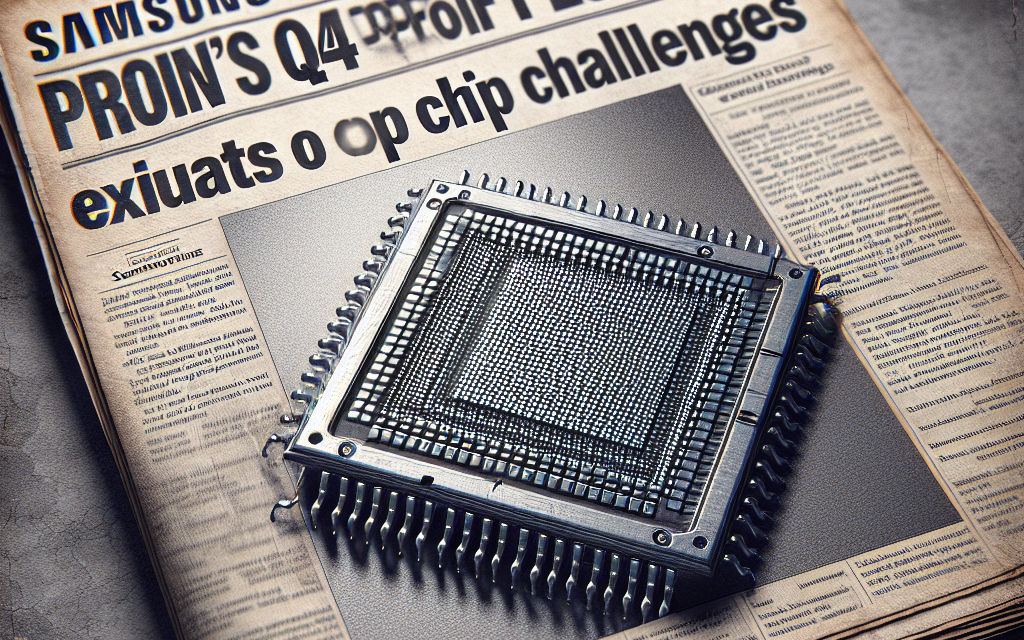“Samsung’s Q4 Profit Falls Short as Chip Challenges Take a Toll.”
Introduction
Samsung Electronics reported a disappointing fourth-quarter profit, falling short of market expectations primarily due to ongoing challenges in the semiconductor sector. The company faced significant headwinds from reduced demand for memory chips, which have been impacted by a global economic slowdown and inventory adjustments among key customers. This profit miss highlights the broader struggles within the semiconductor industry, as companies navigate fluctuating market conditions and strive to maintain profitability amidst rising production costs and competitive pressures.
Samsung’s Q4 Profit Overview
In the fourth quarter of the fiscal year, Samsung Electronics reported a profit that fell short of market expectations, primarily due to ongoing challenges in the semiconductor sector. The company, which is a global leader in various technology segments, including smartphones and consumer electronics, faced significant headwinds that impacted its overall financial performance. Analysts had anticipated a more robust profit margin, but the realities of the semiconductor market proved to be more complex than initially projected.
The semiconductor industry, which has been a cornerstone of Samsung’s profitability, has experienced fluctuations in demand and pricing. This volatility has been exacerbated by a combination of factors, including geopolitical tensions, supply chain disruptions, and a general slowdown in consumer electronics sales. As a result, Samsung’s semiconductor division, which typically contributes a substantial portion of the company’s revenue, reported lower-than-expected earnings. This decline was particularly pronounced in the memory chip segment, where oversupply and reduced demand from key customers, such as smartphone manufacturers and data centers, led to a significant drop in prices.
Moreover, the competitive landscape in the semiconductor market has intensified, with rivals also vying for market share. This competition has not only pressured prices but has also forced Samsung to reassess its production strategies. In light of these challenges, the company has been compelled to implement cost-cutting measures and optimize its manufacturing processes to maintain profitability. However, these adjustments take time to yield results, and the immediate impact on the fourth-quarter earnings was evident.
In addition to the semiconductor challenges, Samsung’s consumer electronics division also faced hurdles. The global economic environment has shifted, with rising inflation and changing consumer behavior affecting spending patterns. As consumers became more cautious with their expenditures, demand for high-end televisions and home appliances waned. This decline in consumer spending further compounded the difficulties faced by Samsung, as it relies heavily on these segments for revenue generation.
Despite these challenges, Samsung remains committed to innovation and long-term growth. The company has been investing in next-generation technologies, such as artificial intelligence and 5G, which are expected to drive future demand for its products. Furthermore, Samsung’s diversification strategy, which includes expanding its presence in the automotive and healthcare sectors, aims to mitigate risks associated with reliance on the semiconductor market. By broadening its portfolio, Samsung seeks to create new revenue streams that can help offset fluctuations in its traditional markets.
Looking ahead, analysts suggest that Samsung’s recovery will depend on several factors, including the stabilization of the semiconductor market and a rebound in consumer demand. While the fourth-quarter results may have disappointed investors, the company’s strong brand reputation and commitment to research and development position it well for future growth. As Samsung navigates these challenges, it will be crucial for the company to adapt to the evolving market landscape and leverage its technological expertise to maintain its competitive edge.
In conclusion, while Samsung’s fourth-quarter profit missed estimates due to significant challenges in the semiconductor sector and a slowdown in consumer electronics sales, the company remains focused on innovation and diversification. By addressing these issues and investing in future technologies, Samsung aims to position itself for recovery and sustained growth in the coming years.
Impact of Chip Shortages on Samsung’s Earnings
Samsung Electronics, a global leader in technology and consumer electronics, has recently reported its fourth-quarter earnings, revealing a significant miss in profit estimates primarily attributed to ongoing challenges in the semiconductor market. The company, which is heavily reliant on its semiconductor division for a substantial portion of its revenue, has faced a myriad of difficulties stemming from chip shortages that have plagued the industry for several years. These shortages have not only affected Samsung’s production capabilities but have also led to increased costs and reduced margins, ultimately impacting the company’s overall financial performance.
As the demand for semiconductors surged during the pandemic, driven by the rapid adoption of digital technologies and remote work solutions, Samsung found itself grappling with supply chain disruptions. The global semiconductor shortage has been exacerbated by various factors, including geopolitical tensions, natural disasters, and the pandemic’s ripple effects on manufacturing. Consequently, Samsung’s ability to meet the rising demand for its products, particularly in the smartphone and consumer electronics sectors, has been hampered. This situation has forced the company to navigate a complex landscape where it must balance production capacity with the fluctuating needs of its customers.
Moreover, the semiconductor division, which is a cornerstone of Samsung’s business model, has seen its profitability erode due to these challenges. The company has reported that the costs associated with sourcing raw materials and components have risen sharply, further squeezing margins. As a result, Samsung’s earnings from this segment have not only fallen short of expectations but have also raised concerns about the sustainability of its growth trajectory in the face of persistent supply chain issues. The impact of these challenges is particularly pronounced given that the semiconductor business is a key driver of innovation and competitiveness for Samsung, influencing its ability to launch new products and maintain market leadership.
In addition to the immediate financial implications, the chip shortages have broader ramifications for Samsung’s strategic initiatives. The company has been investing heavily in research and development to advance its semiconductor technology and expand its manufacturing capabilities. However, the ongoing supply constraints have diverted resources and attention away from these critical projects, potentially hindering Samsung’s long-term growth prospects. As the company seeks to innovate and differentiate itself in an increasingly competitive market, the ability to secure a stable supply of semiconductors will be paramount.
Furthermore, the challenges faced by Samsung are reflective of a larger trend within the technology sector, where companies are increasingly vulnerable to supply chain disruptions. As businesses across various industries continue to rely on advanced technologies, the demand for semiconductors is expected to remain robust. This reality underscores the importance of strategic planning and investment in supply chain resilience, as companies like Samsung must adapt to an environment characterized by volatility and uncertainty.
In conclusion, Samsung’s fourth-quarter earnings miss serves as a stark reminder of the profound impact that chip shortages can have on a company’s financial health and operational capabilities. As the semiconductor market continues to grapple with supply constraints, Samsung will need to navigate these challenges carefully to safeguard its position as a leader in the technology sector. The company’s ability to adapt and innovate in response to these pressures will ultimately determine its success in the coming years, as it strives to maintain its competitive edge in an ever-evolving landscape.
Analysis of Samsung’s Financial Performance in Q4
In the fourth quarter of the fiscal year, Samsung Electronics reported a profit that fell short of market expectations, primarily due to ongoing challenges in the semiconductor sector. This underperformance has raised concerns among investors and analysts alike, as the company grapples with a significant downturn in demand for chips, which have historically been a cornerstone of its profitability. The semiconductor division, which has been a major revenue driver for Samsung, faced a confluence of factors that contributed to this disappointing financial outcome.
To begin with, the global semiconductor market has been experiencing a notable slowdown, driven by a combination of reduced consumer demand and inventory corrections across various industries. As companies recalibrate their stock levels in response to changing market conditions, the demand for memory chips, particularly DRAM and NAND flash, has diminished. This decline in demand has led to a significant drop in prices, further squeezing margins for manufacturers like Samsung. Consequently, the company reported a sharp decline in its semiconductor revenue, which has historically accounted for a substantial portion of its overall earnings.
Moreover, the competitive landscape in the semiconductor industry has intensified, with rivals such as SK Hynix and Micron Technology also facing similar challenges. This increased competition has not only pressured prices but has also forced Samsung to navigate a complex environment where innovation and cost management are paramount. As a result, the company has had to make strategic decisions regarding production levels and capital expenditures, which may have long-term implications for its market position.
In addition to the semiconductor challenges, Samsung’s broader business segments have also been affected by macroeconomic factors. The consumer electronics division, which includes smartphones and home appliances, has seen a slowdown in sales as inflationary pressures and economic uncertainty have led consumers to tighten their spending. This trend has been particularly evident in the premium smartphone market, where competition from other manufacturers has intensified. As a result, Samsung’s overall revenue growth has been stymied, compounding the difficulties faced by its semiconductor division.
Despite these challenges, it is important to note that Samsung remains a formidable player in the technology sector. The company has a robust portfolio of products and services, and its commitment to research and development positions it well for future growth. Furthermore, Samsung’s efforts to diversify its business operations, including investments in artificial intelligence and 5G technology, may provide new avenues for revenue generation in the coming years. However, the immediate outlook remains uncertain, as the semiconductor market is expected to take time to recover.
In conclusion, Samsung’s Q4 financial performance underscores the complexities of operating in a rapidly evolving technology landscape. The company’s profit miss highlights the significant impact of semiconductor market dynamics and broader economic conditions on its overall performance. As Samsung navigates these challenges, its ability to adapt and innovate will be crucial in maintaining its competitive edge. While the current environment poses hurdles, the company’s strategic initiatives and strong market presence may ultimately enable it to rebound and capitalize on future opportunities. Thus, stakeholders will be closely monitoring Samsung’s next moves as it seeks to regain momentum in a challenging market.
Future Outlook for Samsung Amid Chip Challenges
As Samsung navigates the complexities of the semiconductor market, the company faces a challenging landscape that has significant implications for its future outlook. The recent announcement of its fourth-quarter profit missing estimates underscores the ongoing difficulties within the chip sector, which has been exacerbated by a combination of global supply chain disruptions and fluctuating demand. These challenges are not merely short-term hurdles; they represent a broader trend that could shape Samsung’s strategic direction in the coming years.
In light of these circumstances, Samsung is likely to reassess its operational strategies to mitigate the impact of chip shortages and price volatility. The company has historically been a leader in semiconductor manufacturing, but the current environment necessitates a more agile approach. This may involve diversifying its supply chain to reduce dependency on specific markets or suppliers, thereby enhancing resilience against future disruptions. By investing in alternative sourcing strategies, Samsung can better position itself to respond to the unpredictable nature of the semiconductor industry.
Moreover, Samsung’s commitment to innovation will play a crucial role in its future success. The company has consistently invested in research and development, and this focus is expected to continue as it seeks to advance its semiconductor technology. By prioritizing the development of next-generation chips, Samsung can not only improve its competitive edge but also cater to the evolving needs of various sectors, including artificial intelligence, 5G, and automotive technologies. This proactive stance on innovation may help the company regain its footing in a market that is increasingly characterized by rapid technological advancements.
Additionally, Samsung’s strategic partnerships and collaborations will be vital in navigating the current chip challenges. By forging alliances with other technology firms and research institutions, Samsung can leverage shared expertise and resources to accelerate its development efforts. Such collaborations may also facilitate access to new markets and customer segments, thereby broadening the company’s revenue base. As the semiconductor landscape continues to evolve, these partnerships could prove instrumental in ensuring Samsung remains at the forefront of industry developments.
Furthermore, the global economic climate will undoubtedly influence Samsung’s trajectory. As countries emerge from the pandemic and economies begin to stabilize, demand for consumer electronics and other technology products is expected to rebound. However, this recovery may be uneven, with certain regions experiencing faster growth than others. Samsung must remain vigilant and adaptable to these shifts in demand, ensuring that its production capabilities align with market needs. By maintaining flexibility in its operations, the company can better navigate the uncertainties that lie ahead.
In conclusion, while Samsung’s recent profit miss highlights the immediate challenges posed by the semiconductor market, the company’s future outlook remains cautiously optimistic. By focusing on supply chain diversification, investing in innovation, fostering strategic partnerships, and adapting to global economic trends, Samsung can position itself to overcome current obstacles and capitalize on emerging opportunities. The path forward may be fraught with challenges, but with a proactive and strategic approach, Samsung has the potential to not only weather the storm but also emerge stronger in the competitive landscape of the technology industry. As the company continues to adapt and evolve, its resilience will be tested, but its commitment to excellence and innovation will likely guide it through these turbulent times.
Comparison of Samsung’s Q4 Results with Competitors
In the competitive landscape of the technology sector, Samsung’s fourth-quarter results have drawn attention, particularly in light of the challenges it faced in the semiconductor market. While Samsung reported a decline in profits, it is essential to contextualize these results by comparing them with those of its key competitors. This comparison not only highlights the unique hurdles Samsung encountered but also sheds light on broader industry trends.
Samsung’s Q4 profit fell short of analysts’ expectations, primarily due to a significant downturn in its semiconductor business. The company, which is one of the largest chip manufacturers globally, experienced a sharp decline in demand for memory chips, a critical component in various electronic devices. This situation stands in stark contrast to some of its competitors, such as Taiwan Semiconductor Manufacturing Company (TSMC), which reported robust growth during the same period. TSMC’s ability to capitalize on the increasing demand for advanced chips, particularly in the automotive and high-performance computing sectors, underscores the divergent paths taken by these industry giants.
Moreover, while Samsung struggled with its semiconductor division, other technology firms like Intel and Micron Technology also faced their own challenges. Intel, for instance, has been grappling with production delays and competitive pressures, which have hindered its ability to regain market share. However, unlike Samsung, Intel’s issues stem from internal operational inefficiencies rather than a significant drop in demand. This distinction is crucial, as it indicates that while the semiconductor market is experiencing turbulence, the reasons behind each company’s performance vary significantly.
In addition to TSMC’s success, companies like NVIDIA have also thrived in the current market environment. NVIDIA’s focus on graphics processing units (GPUs) for gaming and artificial intelligence applications has positioned it favorably, allowing it to achieve record revenues. This success highlights a shift in consumer demand towards specialized chips, which contrasts with Samsung’s reliance on memory chips that have seen a decline in prices and demand. As a result, Samsung’s inability to pivot quickly to meet changing market needs has contributed to its disappointing Q4 results.
Furthermore, the competitive landscape is further complicated by geopolitical factors and supply chain disruptions that have affected the entire semiconductor industry. While Samsung has been proactive in addressing these challenges, its competitors have also been navigating similar issues. For instance, companies like AMD have managed to maintain a competitive edge by diversifying their product offerings and focusing on high-growth areas such as data centers and cloud computing. This strategic approach has allowed them to mitigate some of the adverse effects experienced by the broader semiconductor market.
In conclusion, Samsung’s Q4 profit miss serves as a reminder of the volatile nature of the technology sector, particularly within the semiconductor industry. While the company faced unique challenges that led to its disappointing results, a comparison with competitors reveals a more complex picture. TSMC’s growth, NVIDIA’s success, and the struggles of Intel and Micron illustrate the varying strategies and market conditions that define this competitive landscape. As Samsung navigates these challenges, it will be crucial for the company to adapt its strategies to align with evolving market demands and capitalize on emerging opportunities. The ability to innovate and respond to shifts in consumer preferences will ultimately determine Samsung’s position in the ever-changing technology arena.
Strategies Samsung Might Employ to Overcome Chip Issues
In light of Samsung’s recent announcement regarding its fourth-quarter profit, which fell short of market expectations primarily due to ongoing challenges in the semiconductor sector, it becomes imperative to explore the strategies the company might employ to navigate these difficulties. The semiconductor industry has been grappling with supply chain disruptions, fluctuating demand, and increased competition, all of which have significantly impacted Samsung’s profitability. To address these challenges, Samsung could consider a multifaceted approach that encompasses both short-term and long-term strategies.
One potential strategy involves increasing investment in research and development (R&D). By allocating more resources to R&D, Samsung can enhance its technological capabilities and innovate new semiconductor solutions that meet the evolving demands of the market. This could include developing advanced manufacturing processes or exploring new materials that could improve chip performance and efficiency. Furthermore, investing in R&D may enable Samsung to differentiate its products from competitors, thereby capturing a larger market share in the semiconductor space.
In addition to bolstering R&D efforts, Samsung might also seek to strengthen its partnerships and collaborations within the industry. By forging strategic alliances with other technology firms, research institutions, and even government entities, Samsung can leverage shared expertise and resources to tackle the semiconductor challenges more effectively. Collaborative initiatives could lead to joint ventures focused on developing next-generation chips or optimizing supply chain logistics, ultimately enhancing Samsung’s resilience against market fluctuations.
Moreover, Samsung could consider diversifying its supply chain to mitigate risks associated with semiconductor shortages. By identifying alternative suppliers and establishing relationships with multiple sources for raw materials and components, Samsung can reduce its dependency on any single supplier. This diversification strategy would not only help stabilize production but also provide greater flexibility in responding to market demands. Additionally, investing in local manufacturing capabilities could further insulate Samsung from global supply chain disruptions, ensuring a more reliable flow of semiconductors.
Another avenue for Samsung to explore is the expansion of its semiconductor manufacturing capacity. As demand for chips continues to rise, particularly in sectors such as automotive, artificial intelligence, and the Internet of Things, increasing production capabilities could position Samsung to capitalize on this growth. This expansion could involve upgrading existing facilities or constructing new plants equipped with cutting-edge technology. By ramping up production, Samsung would be better positioned to meet customer needs and potentially regain market share lost to competitors during periods of supply constraints.
Furthermore, Samsung might also focus on enhancing its operational efficiency. Streamlining manufacturing processes and adopting lean production techniques could help reduce costs and improve output. By optimizing operations, Samsung can not only mitigate the impact of rising production costs but also ensure that it remains competitive in pricing, which is crucial in a market characterized by intense competition.
In conclusion, while Samsung faces significant challenges in the semiconductor sector that have impacted its fourth-quarter profits, the company has several strategies at its disposal to overcome these issues. By investing in R&D, strengthening partnerships, diversifying its supply chain, expanding manufacturing capacity, and enhancing operational efficiency, Samsung can position itself to navigate the complexities of the semiconductor market effectively. Through these strategic initiatives, Samsung can not only address current challenges but also lay the groundwork for sustainable growth in the future.
Investor Reactions to Samsung’s Q4 Profit Miss
Samsung’s recent announcement regarding its fourth-quarter profit has elicited a range of reactions from investors, particularly in light of the company’s performance falling short of market expectations. The tech giant reported a significant decline in profits, primarily attributed to ongoing challenges in the semiconductor sector. This development has raised concerns among stakeholders, prompting a reevaluation of the company’s future prospects and strategic direction.
As investors digested the news, many expressed disappointment over the profit miss, which was largely driven by a combination of reduced demand for chips and increased competition in the market. The semiconductor industry, which has been a cornerstone of Samsung’s profitability, is currently facing headwinds due to a global oversupply and weakening demand from key sectors such as consumer electronics and automotive. Consequently, this has led to a downward revision of earnings forecasts, further exacerbating investor anxiety.
In response to the profit miss, Samsung’s stock experienced a notable decline, reflecting the immediate impact of the news on investor sentiment. Analysts have pointed out that the company’s reliance on its semiconductor division for a substantial portion of its revenue makes it particularly vulnerable to fluctuations in this sector. As a result, many investors are now questioning the sustainability of Samsung’s growth trajectory, especially in light of the increasing volatility in the semiconductor market.
Moreover, the broader economic environment has added another layer of complexity to Samsung’s situation. With rising interest rates and inflationary pressures affecting consumer spending, the demand for electronic devices has softened. This trend has not only impacted Samsung’s chip sales but has also raised concerns about the company’s ability to navigate a challenging economic landscape. Investors are closely monitoring these macroeconomic factors, as they could further influence Samsung’s performance in the coming quarters.
Despite the immediate negative reactions, some investors remain cautiously optimistic about Samsung’s long-term prospects. They argue that the company has a strong track record of innovation and adaptability, which could position it well to recover from current challenges. Additionally, Samsung’s investments in next-generation technologies, such as artificial intelligence and 5G, may provide new avenues for growth. This perspective suggests that while the short-term outlook may be clouded, the company’s strategic initiatives could ultimately lead to a rebound.
Furthermore, analysts have emphasized the importance of Samsung’s diversification efforts. By expanding its portfolio beyond semiconductors and into areas such as consumer electronics and display technologies, the company may mitigate some of the risks associated with its reliance on chip sales. Investors are keenly aware of these developments and are likely to weigh them heavily in their assessments of Samsung’s future performance.
In conclusion, the investor reactions to Samsung’s fourth-quarter profit miss reflect a complex interplay of immediate disappointment and cautious optimism. While the challenges in the semiconductor market have raised valid concerns about the company’s short-term profitability, the potential for long-term recovery through innovation and diversification remains a focal point for many stakeholders. As Samsung navigates this turbulent period, the responses from investors will undoubtedly shape the company’s strategic decisions and market positioning in the months ahead.
Q&A
1. **What was Samsung’s Q4 profit for 2022?**
Samsung reported a Q4 profit of approximately $3.4 billion.
2. **Why did Samsung’s Q4 profit miss estimates?**
The profit miss was primarily due to challenges in the semiconductor market, including oversupply and declining prices.
3. **What impact did chip challenges have on Samsung’s overall business?**
The chip challenges negatively affected Samsung’s semiconductor division, which is a significant contributor to its overall revenue.
4. **How did analysts react to Samsung’s Q4 results?**
Analysts expressed concern over the ongoing semiconductor market issues and the potential for continued profit declines in the future.
5. **What measures is Samsung considering to address the chip challenges?**
Samsung is exploring production cuts and adjusting its investment strategies to stabilize the semiconductor market.
6. **What was the market’s response to Samsung’s Q4 profit miss?**
Following the announcement, Samsung’s stock experienced a decline as investors reacted to the disappointing results.
7. **What are the future outlooks for Samsung in the semiconductor sector?**
Analysts predict a slow recovery for the semiconductor sector, with potential improvements in demand expected in the latter half of the year.
Conclusion
Samsung’s Q4 profit miss can be attributed to ongoing challenges in the semiconductor market, including reduced demand and pricing pressures. These factors have significantly impacted the company’s overall performance, highlighting the vulnerability of its chip division amidst a fluctuating global economy. As a result, Samsung may need to reassess its strategies to navigate these challenges and stabilize its profitability moving forward.





